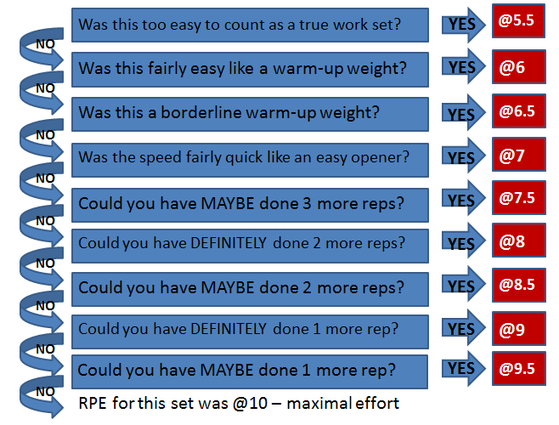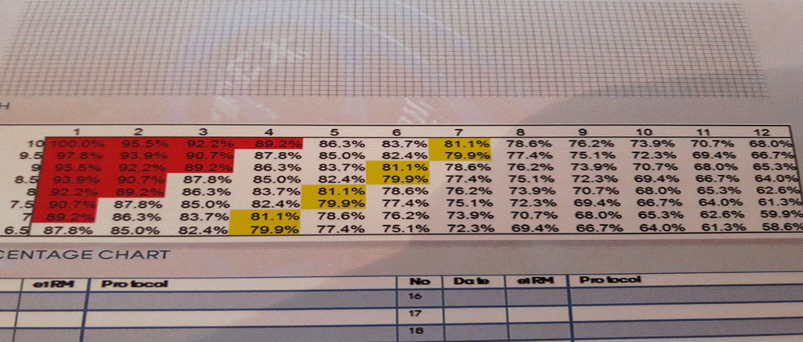|
Although the idea of using RPE (Rate of Perceived Exertion) is not a new concept, it's resurgence in the powerlifting and strength training community, is largely due to Mike Tuchscherer at Reactive Training Systems*. For those who may be unaware, RPE based training is where you determine the weight used for a specific lift or set of lifts, by assigning it a number out of 10 in relation to how difficult it was, and you judge that difficulty by how many reps you could have done. credit to Reactive Training Systems I think it's very useful and does, like anything, have pros and cons. So, I'm going to expand on both then give my general opinion as both a coach and a lifter. Let's get the negatives done first, one of the biggest criticisms of RPE based training is that it requires a very objective view of one's own lifting and very much requires you to check your ego at the door. It can very much be misused on both ends of the spectrum, for example constantly under loading weight and being extremely reluctant to really push. As well as being overzealous and kidding yourself that the single you just ground out for 1 rep was an 8RPE. There is very little I can say to counter these points, only that it’s an issue with the lifter rather than the system itself. Both will stall progress in that if you under-lift constantly you won't get anywhere, and if you over reach frequently, you will eventually auto-regulate through injury. To further expand on the under-lifting point, a lot of people don't like the idea of 'wiggle' room and feel that if they have a X reps and Y% in their programme, they just have to hit those numbers in the gym. I do understand where they're coming from, it would be very easy when things get tough to under-lift but again, your own objectivity needs to come into it. This is a lot less of an issue when you work day to day with an in-person coach or trainer. They are another set of eyes on how things are moving and how it compares to how you normally operate. There will be times where you may be unfocused and feel awful, but the weights are moving great and there is no noticeable performance drop off, in which case nothing needs changed. Where I believe RPE based training takes it to the next level over purely percentage based, is when people are self-coached. One issue I and people I've talked to before have had is, what happens when you can't do the prescribed weights? You're programmed work for the day is 3 sets of 3 at 88% of your 1RM. What happens if you do your first rep and it's awfully slow and there's little to no chance of you getting another one, let alone two reps? Do you drop the weight and complete 3x3 at a lower weight? If so, how much do you drop? These things aren't covered in a lot of programmes, however if we changed the annotation from 3x3@ 88% to 3x3@ 8RPE it allows you to make a much better choice. As you were working up, things not feeling great, you can just complete 3x3 at a weight that you could’ve hit for 2 more reps. On the back of that, lets transition into the positives. The general theme of RPE based training is to make better training decisions. For those that are hard wired for percentages, like everything good in this world, there's a chart for that. Columns indicated reps, rows indicate RPE. Credit to Reactive Training Systems, Mike Tuchscherer. Certainly for me this tied a lot of loose ends together, for example you can instantly start translating your favourite set rep schemes into RPEs and see how they compare. It's not all about having to tone things down either. The system is equally useful if you're feeling great and demolishing weights. Working up to a specific intensity rather than pre-set weight percentage means that if you crush your top set, you don't have to stop there. Keep working up until it meets the specific intensity parameters. Another slightly more advanced nuance where RPE shines, is that you can build your own RPE scale specific to you. Let's make an example of someone who has a lower back injury, and wants to avoid anything that would place anything above minimal amounts of shear forces on the spine. Just for catch up, shear forces are unaligned forces pushing one part of a body in one direction, and another part of the body in the opposite direction. Think tearing a piece of paper. If you were trying to avoid these in the squat for example, you'd be looking to stick entirely to high bar position and avoid any chest fall. So you could cater your own RPE scale to include that, so an 8RPE might be “could definitely get 2 more reps with no chest fall”.
So if you find yourself frequently missing training reps using straight percentages, you may want to give RPE based stuff a go. A simple way to start would be to not change anything straight away, and just reference the RPE chart, and start practising rating your lifts whilst sticking to your regular programme. Just do you lifts as normal, but as soon as you re rack the bar think about how hard that set was, how many reps did I have in the tank? Then compare it versus the percentage conversion chart and see how it holds up! As always if you have any questions or comments please let me know either here or @atsapproved.
1 Comment
26/6/2023 12:40:56
Really appreciate you sharing this article post. Thanks Again.
Reply
Leave a Reply. |
Archives
March 2024
Categories
All
|
Proudly powered by Weebly



 RSS Feed
RSS Feed